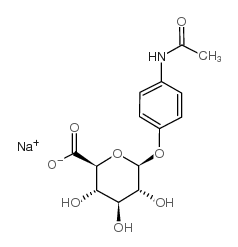acetaminophen glucuronide sodium salt

acetaminophen glucuronide sodium salt structure
|
Common Name | acetaminophen glucuronide sodium salt | ||
|---|---|---|---|---|
| CAS Number | 120595-80-4 | Molecular Weight | 349.27 | |
| Density | N/A | Boiling Point | N/A | |
| Molecular Formula | C14H16NNaO8 | Melting Point | 232-233ºC (dec) | |
| MSDS | Chinese USA | Flash Point | N/A | |
|
Transporter-mediated uptake of UDP-glucuronic acid by human liver microsomes: assay conditions, kinetics, and inhibition.
Drug Metab. Dispos. 43(1) , 147-53, (2014) This study characterized the kinetics, variability, and factors that affect UDP-glucuronic acid (UDP-GlcUA) uptake by human liver microsomes (HLM). Biphasic kinetics were observed for UDP-GlcUA uptake by HLM. Uptake affinities (assessed as Kd) of the high- an... |
|
|
Development of a SPE-UHPLC-MS/MS methodology for the determination of non-steroidal anti-inflammatory and analgesic pharmaceuticals in seawater.
J. Pharm. Biomed. Anal. 106 , 61-70, (2015) An analytical methodology for the simultaneous determination of seven pharmaceuticals and two metabolites belonging to the non-steroidal anti-inflammatory drugs (NSAIDs) and analgesics therapeutic groups was developed based on off-line solid-phase extraction ... |
|
|
The effect of sunitinib on the plasma exposure of intravenous paracetamol and its major metabolite: paracetamol glucuronide.
Eur. J. Drug Metab. Pharmacokinet. 40 , 163-70, (2015) The study aimed to examine the effect of sunitinib on the plasma exposure of intravenous paracetamol and its major metabolite, paracetamol glucuronide. Both drugs share metabolic pathways in the liver, and the drug interactions between sunitinib and paracetam... |
|
|
Uridine Diphosphate-Glucuronosyltransferase (UGT) Xenobiotic Metabolizing Activity and Genetic Evolution in Pinniped Species.
Toxicol. Sci. 147 , 360-9, (2015) There are various interspecies differences in xenobiotic-metabolizing enzymes. It is known that cats show slow glucuronidation of drugs such as acetaminophen and strong side effects due to the UGT1A6 pseudogene. Recently, the UGT1A6 pseudogene was found in th... |
|
|
Favipiravir inhibits acetaminophen sulfate formation but minimally affects systemic pharmacokinetics of acetaminophen.
Br. J. Clin. Pharmacol. 80 , 1076-85, (2015) The antiviral agent favipiravir is likely to be co-prescribed with acetaminophen (paracetamol). The present study evaluated the possiblility of a pharmacokinetic interaction between favipiravir and acetaminophen, in vitro and in vivo.The effect of favipivir o... |
|
|
Altered disposition of acetaminophen in Nrf2-null and Keap1-knockdown mice.
Toxicol. Sci. 109 , 31-40, (2009) Acetaminophen (AA) is a widely used antipyretic drug that causes hepatotoxicity at high doses. Nuclear factor erythroid 2-related factor 2 (Nrf2) is a transcription factor that mitigates electrophilic stress from AA by inducing genes, such as NAD(P)H:quinone ... |
|
|
Pharmacometabonomic identification of a significant host-microbiome metabolic interaction affecting human drug metabolism.
PLoS Pathog. 106 , 14728-14733, (2009) We provide a demonstration in humans of the principle of pharmacometabonomics by showing a clear connection between an individual's metabolic phenotype, in the form of a predose urinary metabolite profile, and the metabolic fate of a standard dose of the wide... |
|
|
Exacerbation of acetaminophen hepatotoxicity by the anthelmentic drug fenbendazole.
Toxicol. Sci. 125 , 607-612, (2012) Fenbendazole is a broad-spectrum anthelmintic drug widely used to prevent or treat nematode infections in laboratory rodent colonies. Potential interactions between fenbendazole and hepatotoxicants such as acetaminophen are unknown, and this was investigated ... |